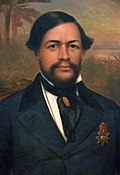Portal:Hawaii
The Hawaii Portal Hawaii (/həˈwaɪ.i/ ⓘ hə-WY-ee; Hawaiian: Hawaiʻi [həˈvɐjʔi, həˈwɐjʔi]) is an island state of the United States, in the Pacific Ocean about 2,000 miles (3,200 km) southwest of the U.S. mainland. One of the two non-contiguous U.S. states (along with Alaska), it is the only state not on the North American mainland, the only state that is an archipelago, and the only state in the tropics. Hawaii consists of 137 volcanic islands that comprise almost the entire Hawaiian archipelago (the exception, which is outside the state, is Midway Atoll). Spanning 1,500 miles (2,400 km), the state is physiographically and ethnologically part of the Polynesian subregion of Oceania. Hawaii's ocean coastline is consequently the fourth-longest in the U.S., at about 750 miles (1,210 km). The eight main islands, from northwest to southeast, are Niʻihau, Kauaʻi, Oʻahu, Molokaʻi, Lānaʻi, Kahoʻolawe, Maui, and Hawaiʻi, after which the state is named; the last is often called the "Big Island" or "Hawaiʻi Island" to avoid confusion with the state or archipelago. The uninhabited Northwestern Hawaiian Islands make up most of the Papahānaumokuākea Marine National Monument, the largest protected area in the U.S. and the fourth-largest in the world. Of the 50 U.S. states, Hawaii is the fourth-smallest in land area and the 11th-least populous; but with 1.4 million residents, it ranks 13th in population density. Two-thirds of Hawaii residents live on Oʻahu, home to the state's capital and largest city, Honolulu. Hawaii is one of the most demographically diverse U.S. states, owing to its central location in the Pacific and over two centuries of migration. As one of only seven majority-minority states, it has the only Asian American plurality, the largest Buddhist community, and largest proportion of multiracial people in the U.S. Consequently, Hawaii is a unique melting pot of North American and East Asian cultures, in addition to its indigenous Hawaiian heritage. Settled by Polynesians sometime between 1000 and 1200 CE, Hawaii was home to numerous independent chiefdoms. In 1778, British explorer James Cook was the first known non-Polynesian to arrive at the archipelago. The Kingdom of Hawaii was established in 1795 when Kamehameha I, then Aliʻi nui of Hawaii, conquered the islands of Oʻahu, Maui, Molokaʻi, and Lānaʻi, and forcefully unified them under one government. In 1810, the Hawaiian Islands were fully unified when Kauaʻi and Niʻihau joined. An influx of European and American explorers, traders, and whalers arrived in the following decades, leading to substantial population declines among the once-immunologically isolated indigenous community through repeated virgin soil epidemics. American and European businessmen overthrew the monarchy in 1893 and established a short-lived transitional republic; this led to annexation by the United States (U.S.) in 1898. As a strategically valuable U.S territory, Hawaii was attacked by Japan on December 7, 1941, which brought it global and historical significance, and contributed to America's entry into World War II. Hawaii is the most recent state to join the union, on August 21, 1959. (Full article...) This is a Featured article, which represents some of the best content on English Wikipedia..
 The 1881 world tour of King Kalākaua of the Hawaiian Kingdom was his attempt to save the Hawaiian culture and population from extinction by importing a labor force from Asia-Pacific nations. His efforts brought the small island nation to the attention of world leaders, but sparked rumors that the kingdom was for sale. Critics in Hawaii believed the labor negotiations were just an excuse to see the world. The 281-day trip gave Kalākaua the distinction of being the first monarch to circumnavigate the globe; his 1874 travels had made him the first reigning monarch to visit the United States and the first honoree of a state dinner at the White House. (Full article...) This is a Good article, an article that meets a core set of high editorial standards.
Emma ʻAʻima Aʻii Nāwahī (September 28, 1854 – December 28, 1935) was a Native Hawaiian political activist, community leader and newspaper publisher. She and her husband Joseph Nāwahī were leaders in the opposition to the overthrow of the Kingdom of Hawaiʻi and they co-founded Ke Aloha Aina, a Hawaiian language newspaper, which served as an important voice in the resistance to the annexation of Hawaiʻi to the United States. After annexation, she helped establish the Democratic Party of Hawaiʻi and became a supporter of the women's suffrage movement. (Full article...) Selected Picture - 'Ōlelo (Language) -This section is here to highlight some of the most common words of the Hawaiian Language, ʻŌlelo, that are used in everyday conversation amongst locals.
E komo mai
Welcome State Facts
State Symbols:
Selected article -Hawaii Five-O is an American police procedural drama series produced by CBS Productions and created by Leonard Freeman. Set in Hawaii, the show aired for 12 seasons on CBS from September 20, 1968, to April 5, 1980. The show starred Jack Lord as Detective Captain Stephen "Steve" McGarrett, the head of a fictional state police task force in Hawaii. The theme music composed by Morton Stevens became especially popular. Many episodes in the series would end with McGarrett's catchphrase, "Book 'em, Danno!" At the airing of its finale, it was the longest-running police drama in American television history, and the last scripted primetime show that debuted in the 1960s to leave the air. (Full article...) Did you know? -
Hawaii News
Wikinews Hawaii portal
Quotes - "Ua mau ke ea o ka ʻāina i ka pono." — King Kamehameha III (Later became the Hawaiʻi State Motto.) On this day...There are no anniversaries listed for this day. Related portalsTopicsCategoriesAssociated WikimediaThe following Wikimedia Foundation sister projects provide more on this subject:
SourcesDiscover Wikipedia using portals |















